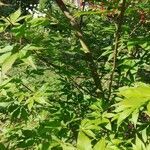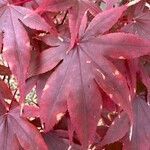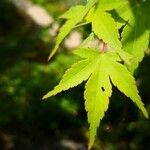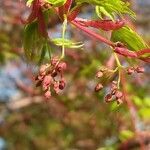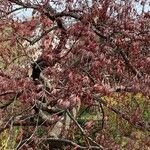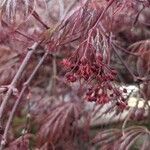Trees deciduous, andromonoecious, to 15 m tall. Bark greenish gray or light brown, smooth. Branchlets grayish green, glabrous; winter buds purplish red, conical, small, with 5 pairs of scales, ciliate, terminal buds usually absent. Petiole 2-6 cm; leaf blade suborbicular, 3-6 × 4-8 cm, membranous to papery, yellowish brown pubescent when unfolding, soon glabrous except for axillary tuft of hairs on abaxial surface, base cordate to subtruncate, palmately 5-or 7-lobed to middle; lobes lanceolate, margin irregularly doubly serrate, apex long acuminate. Inflorescence corymbose-paniculate, 10-20-flowered, 3-4 cm, half-pendulous, subtended by 1 or 2 pairs of leaves. Flowers opening with leaves. Sepals 5, purplish red, oblong to oblanceolate, ca. 3 mm, pubescent near margin. Petals pale yellow to pinkish white, broadly obovate, smaller than sepals, glabrous. Stamens 8, exserted, ca. 3.5 mm, shorter in pistillate flowers, inserted at inside of disk. Ovary glabrous; style long, topped by divergent stigmas. Abortive pistil in staminate flowers minute. Samaras ca. 1.5 cm with wing, glabrous; wings spreading at obtuse angle; nutlets elliptic-convex, only slightly veined with thin, weak wall. Fl. Apr-May, fr. Sep. 2n = 26.
More
Wide-crowned, shrub or deciduous tree to c. 7 m high; andromonoecious. Leaves: lamina palmately 5 (7–11)-lobed, 5–10 cm long and wide, nearly truncate at base, virtually glabrous, usually with a tuft of short hairs near the attachment of the petiole; lobes typically divided to within c. 1 cm of petiole, occasionally completely divided, margins irregularly serrate; petiole 15–35 mm long. Flowers in short, semi-pendent, terminal racemes to c. 4 cm long, appearing with or before leaves; pedicels slender, 3–6 mm long; sepals narrowly obovate, c. 3 mm long, purplish red; petals broadly obovate, shorter than sepals, pale yellowish or tinged pink; nectary disc annular; stamens 8, c. 4 mm long in male flowers, shorter in female flowers, inserted within disc; ovary glabrous. Samaras c. 1.5 cm long, the seed compartment broadly ellipsoid, c. 4 mm long, wings spreading at an obtuse angle.
A deciduous tree. It grows 8 m high and spreads 3 m across. The stem is slender and bends easily. It has greenish grey bark. The crown of the tree is rounded. The leaves are green and divided like the fingers on a hand. They have between 5 and 9 lobes on the leaf. The lobes get more narrow towards the tip. The edges of the leaves are like saw teeth. The leaves are on long leaf stalks. The leaves are up to 15 cm long. The leaves turn orange to red in autumn. The flowers are purple to pink. They are small. They grow on branched stalks with a flat topped effect. These flower stalks hang downwards. The seeds occur in double seed containers and the wings stick out sideways. The wings are red. Many cultivated forms have been developed.
It is a temperate plant. A plant native to China, Japan, and Korea. It requires a well drained soil. It needs fertile soil and an open sunny position. It is drought and frost resistant. It can stand frosts to about-25°C when young shoots are not present. It grows in forests between 200-1200 m altitude in China. Temperate. It suits hardiness zones 6-9. Mt Lofty Botanical Gardens. Burnie Rhodo gardens. Arboretum Tasmania.
More
Woods and thickets in a wide range of soils and exposures in lowland and mountains to 3000 metres in C. and S. Japan.
Recorded from cleared and mown firebreak on edge of wet sclerophyll forest, weedy eucalypt woodland, roadsides.
Widely grown as an ornamental, especially for its autumn-coloured foliage of yellows through to oranges and reds; includes numerous cultivars with various leaf forms (e.g. lamina shapes with various degrees of dissection and lobing; coloured and variegated foliage) and plant habit (many shrubby and dwarf forms); see van Gelderen et al. (1994), Rodd (1996), Coombes (1998), Ellison (1999), Spencer (2002).
More
The sugary sap can be eaten. It is normally collected on a sunny day following a freezing night. The leaves are eaten with oil and salt.
